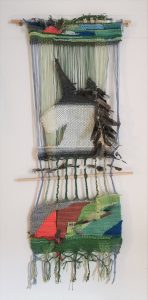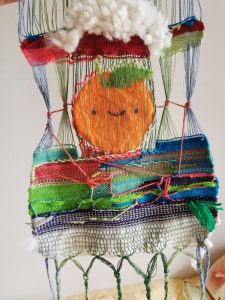Final Weaving- Leilani Zhang
I knew very early on after the weaving project was introduced that I wanted to make some representation of a unicorn, partly because I really appreciated their mythicality as a child, and partly because I was inspired by the delicacy of the Unicorn Tapestries. My original idea was to create a more classical type of tapestry weaving, that would use differences in color to suggest depth and three-dimensionality; however, after completing the sample weaving, I realized that I felt more free when I was able to use the yarns in a non-restrictive, spontaneous way. I also noticed that I liked having contrast between vibrant colors and more muted ones. For my final weaving, I chose to combine these two ideas, to still feature a unicorn, but use more graphic visuals to suggest places and objects, rather than create them literally.
From the bottom, I decided not to use fabric strips to begin my weaving but instead start directly with yarn, so that it would leave some negative space and trail off at the bottom, making it more mysterious. I then used horizontal and vertical rows of green, to suggest grass and grasslands, before moving into blocks that represented woodland colors. I chose blues (water), greens (hills), oranges and reds (flowers), and gray (rocks). I then began a section of braided negative space, to show a transition into a more classical/ mythical unicorn, which is done in black and white and uses horizontal rows to transition in color. The backdrop for the unicorn is left as unwoven warp, as it gives it three-dimensionality and adds more airiness and lightness to the weaving. Finally, the top section uses a combination of interlocking rows and soumak braids, to suggest a vibrant sky that changes with texture. I also used feathers throughout the weaving, primarily to make it less flat, and make the unicorn more animated/ draw attention to parts of the weaving, such as the color shift in the hills, the gradual transition into black and white, or the sun at the top of the weaving. In contrast to my sample weaving, where the ends were finished as an afterthought, I took care to braid the top and bottom warp parts; the top was done as a horizontal twist braid, which wrapped around the stick, and the bottom was a series of braids and decorative trim. This was done as both are common decorative braids used on horses, and I wanted another way of incorporating the “unicorn” element into the tapestry itself.
The process was much more enjoyable, but also much more laborious, than my sample weaving. It definitely taught me the importance of time management, as the graphic shapes was more time-consuming than anticipated. The use of feathers also posed a challenge, as it was difficult to incorporate them in a way that would feel natural throughout the entire weaving, but through trial and error, I was able to learn through it how to balance out the weaving. The use of negative space also reinforced the idea of weight, and how to create balance by alternating space and fabric. In the future, I’d like to continue doing more graphic shapes, and refine my technique in joining together two different colors so the color gradients can be more subtle.

